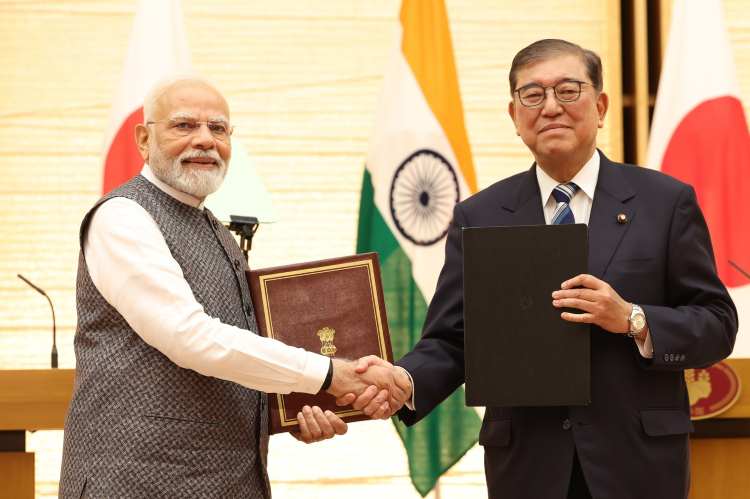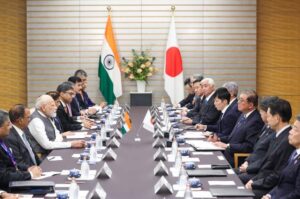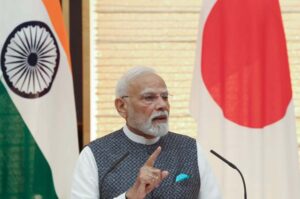
Prime Minister Narendra Modi’s August 2025 visit to Japan was never going to be routine. Against the backdrop of sharpening great power rivalry and economic realignments, the 15th India–Japan Annual Summit in Tokyo produced a sweep of agreements that mark a decisive shift in bilateral relations. Long described as a partnership of promise, the India-Japan ties have now entered a phase that is strategic, future-oriented, and comprehensive.
The centrepiece of the summit was the unveiling of a 10-year vision for cooperation. Unlike earlier joint statements that singled out narrow sectors, the new framework spans economic security, technology, mobility, sustainability, health, human resources, and subnational partnerships. Both governments have moved away from incrementalism to design a roadmap that links national growth with regional stability. The plan explicitly ties economic goals with strategic imperatives, reflecting the reality of an Indo-Pacific defined by both opportunity and contestation.
READ I GST reform still incomplete after eight years
Investment focus for India-Japan ties
Economics remains the anchor. Japan announced nearly ¥10 trillion (about $68 billion) in private sector investment into India over the next decade—more than double the earlier five trillion yen pledge. The commitment signals Japanese confidence in India’s growth prospects at a time when global investors are reassessing supply chains and capital flows. For India, which is pushing infrastructure expansion and industrial corridors, this infusion supports its bid to become a resilient global hub. The Mumbai–Ahmedabad bullet train project, once seen as a flagship, is now part of a wider web of connectivity and technology integration.

Equally significant was the revision of the 2008 Joint Declaration on Security Cooperation. The updated document recognises new domains—cyber, outer space, artificial intelligence, and maritime surveillance. As the Indo-Pacific emerges as the epicentre of strategic rivalry, Tokyo and New Delhi are signalling that their cooperation is indispensable for regional order.
Alongside this was the launch of an Economic Security Initiative. The agenda covers critical minerals, semiconductors, pharmaceuticals, and clean energy technologies—sectors where vulnerabilities exposed by the pandemic still loom large. Japan brings technology and capital, India offers scale and markets. The combination is designed to reduce dependence on fragile supply chains and align economic frameworks with democratic values.
Innovation and digital futures
Technology collaboration was given sharper definition through Digital Partnership 2.0 and the India–Japan AI Initiative. The focus includes digital public infrastructure, IoT, and joint research on artificial intelligence and large language models. Japan’s edge in hardware and India’s software capabilities create a natural complementarity. For both, this is more than cooperation—it is co-creation of technologies that will shape competitiveness in the next decade.

Outer space and climate action received strong emphasis. ISRO and JAXA will jointly work on Chandrayaan-5, targeting the lunar poles. On climate, a new Joint Crediting Mechanism will bring Japanese clean technologies into India’s energy transition. These steps matter not just bilaterally but globally, as countries race to balance growth with carbon reduction.
Mobility and human capital
The human resource agenda was ambitious. A new action plan aims to facilitate half a million exchanges over five years, including 50,000 skilled Indian workers in Japan. This directly addresses Japan’s demographic challenges while expanding opportunities for India’s young workforce. Subnational diplomacy was given prominence through state–prefecture partnerships and new business forums in Kansai and Kyushu, ensuring that ties are rooted beyond capitals and into communities.
The optics reinforced substance. Modi’s ride on the Shinkansen with Prime Minister Shigeru Ishiba symbolised trust in shared technology. The Tokyo Skytree lit up in Indian tricolour and the warmth of the diaspora underlined people-to-people bonds that often outlast official communiqués.
The outcomes mark a turning point. The India-Japan ties, once dominated by economics, has become a multi-dimensional alliance—spanning security, technology, energy, and people. For India, Japan represents capital, technology, and rules-based reliability; for Japan, India offers scale, markets, and a young workforce. Together, they send a message in a fragmented world: that partnerships built on trust and shared values can thrive amid uncertainty.
The Tokyo summit has set the direction for India-Japan ties in the next 10 years. Its decisions will shape not only bilateral ties but also the architecture of the Indo-Pacific, where economic resilience and strategic balance are increasingly intertwined.
Suresh P Singh is Senior Director, VeK Policy Advisory & Research.
